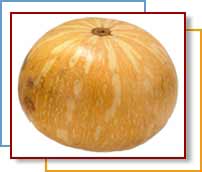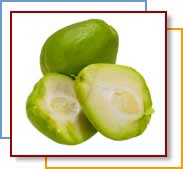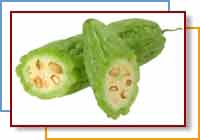
These three exotic vegetables: calabaza squash, chayote squash, and
bitter melon are all becoming more mainstream. All three are being found
more and more in local supermarkets; there may soon be no need to go to a
specialty market to try something new.
| |
| Word to the
Wise |
|
Whole calabaza may be difficult to slice. Slicing through the
tough rind often calls for a heavy cleaver or a very sharp
knife. If the squash resists slicing, remove the stem and place
the knife or cleaver blade along the squash’s length. Gently tap
the blade with a hammer until the squash falls open. Scoop out
the seeds, peel and prepare! |
|
| |
|
Calabaza is a type of pumpkin-like squash that is round in shape and
varies in size. It can be as large as a watermelon or as small as a
cantaloupe. The color of calabaza can also vary and may include greens,
tans, reds and oranges. Some squash are all one color while other calabaza
are multi-colored and may include all of colors listed above. This squash
is popular in the Caribbean as well as Central and South America. It is
also commonly called a West Indian Pumpkin.
Selection
Calabaza is often sold already chopped into chunks in many Latin markets.
This is because of the difficulty many have in chopping the whole squash (see
box below). Select pieces with a fresh, moist and unblemished flesh. Soft
or wet spots means the squash is beginning to spoil. The color of the
flesh should be a bright orange. Whole squash are more difficult to find,
but if you find one, select one that still has the stem attached and is
heavy for its size. You should avoid purchasing a squash with bruises,
cuts, or soft spots. Calabaza is available year round.
 Storage Storage
Whole calabaza may be stored in a cool, dry space for up to 6 weeks. Cut
calabaza should be wrapped tightly or placed in a covered container in the
refrigerated for no more than one week.
Preparation
Calabaza has a sweet flavor and its texture is firm. This is similar to
the taste and texture of more familiar varieties of squash, such as
butternut or acorn. Calabaza may be substituted in recipes calling for
those more common types of squash.
Calabaza is most commonly baked, either cut in sections or in cubes. Its
seeds may also be roasted in a similar way as pumpkin seeds. Simply place
on a baking sheet coated in cooking spray until brown and crisp.
|
|
Chayote Squash |
Serving
size 1/2 cup raw, sliced (66g)
| Amounts
Per Serving |
% Daily
Value |
| Calories
11 |
|
| Calories
from Fat 2 |
|
| Total Fat
0g |
0% |
| Saturated
Fat 0g |
0% |
| Cholesterol
0mg |
0% |
| Sodium
3mg |
0% |
| Total
Carbohydrate 5g |
1% |
|
Dietary Fiber 2g |
47% |
|
Sugars 12g |
|
| Protein 1g |
|
| Vitamin A |
1% |
| Vitamin C |
17% |
| Calcium |
2% |
| Iron |
2% |
* Percent Daily Values are based on a
2,000 calorie diet. |
|
| |
|
Chayote is a gourd-like squash that is about the size and shape of a very
large pear. The skin is pale green and smooth with slight ridges that run
lengthwise. Many compare the color to a light green apple. The flesh is
white and there is one soft seed in the middle. Chayote is grown in several
states including California, Florida, and Louisiana, but it is native to Latin
America. Historically, this squash was one of the primary foods of the
Aztecs and Mayas. Chayote is also called mirliton and the French call it
christophene.
Selection
Select squash that are small, firm and unblemished; just as you would select
a pear. Choose squash that is heavy for its size. Tender skin, skin that
reacts to pressure, often means poor quality. Chayote is commonly found in
supermarkets during peak season (December to March), but may be found in
larger supermarkets and specialty markets throughout the year.
Storage
Refrigerate whole chayote in a plastic bag for up to one month. Cut chayote
may be refrigerated in a covered container or tightly wrapped for 3 to 5
days. It is best to use chopped chayote immediately, as it can gather
flavors from other foods stored in the refrigerator.

Preparation
Chayote has a bland-tasting flesh that may be used in several ways. It may
be prepared in similar ways to other summer squash, such as zucchini, but
may require peeling and a bit more seasoning. Chayote is most commonly used
in side dishes, stews, and casseroles. It may also be sliced in half and
baked. The soft seed is edible, but many choose to remove it.
Bitter melon is actually a member of the squash family and resembles a
cucumber with bumpy skin. When first picked, a bitter melon is
yellow-green, but as it ripens, it turns to a yellow-orange color.
|
|
Bitter Melon |
Serving
size 1/2 cup raw, sliced (47g)
| Amounts
Per Serving |
% Daily
Value |
| Calories
10 |
|
| Calories
from Fat 0 |
|
| Total Fat
0g |
0% |
| Saturated
Fat 0g |
0% |
| Cholesterol
0mg |
0% |
| Sodium
0mg |
0% |
| Total
Carbohydrate 2g |
1% |
|
Dietary Fiber 1g |
4% |
|
Sugars 0g |
|
| Protein 0g |
|
| Vitamin A |
4% |
| Vitamin C |
70% |
| Calcium |
0% |
| Iron |
2% |
* Percent Daily Values are based on a
2,000 calorie diet. |
|
| |
|
The inside of the melon is filled with fibrous seeds. Bitter melon is used
mostly in Asian and Indian cooking. Other names for bitter melon include:
foo qua, balsam pear, or bitter gourd.
Selection
Select firm, unblemished melons that are from 5 to 12 inches in length.
Choose melons that are still green for a more bitter flavor and a
yellow-orange melon for a milder taste. Bitter melons are available fresh
from April to September in most Asian markets and can occasionally be
found in larger supermarkets. Some markets are beginning to carry bitter
melons year round. They may also be purchased canned or dried.
Storage
Store melon loose in a paper or plastic bag in the refrigerator for 3 to 5
days. Slice the melon immediately before use.
Preparation
Cut in half and discard the seeds and fibrous core. To reduce the
bitterness, blanch in boiling water for 2 to 3 minutes. The skin is edible
and the melon is not typically peeled. The seeds are also edible, unless
very hard, and are included in some recipes. Bitter melon is commonly
stuffed, curried or pickled. It can also be used in stir-fry’s and soups
and may be steamed. Garlic or chili peppers are often added to recipes
with bitter melon to offset the bitter taste.
Recipes
Calabaza Soup
Makes 6 servings
Each serving equals 1/2 cup fruit or vegetables
Ingredients
1½ lb Calabaza squash, diced
1 green bell pepper, chopped
1 garlic clove
4 scallions, minced
1 Tbsp dried thyme
1 tsp allspice
1 tsp cumin
1 tsp fenugreek
1 large ripe tomato, chopped
¼ cup coconut milk
¾ cup low-fat milk (1%)
Simmer all the ingredients except the milks in 5 cups of water for 1
hour. Strain the liquid into a bowl and allow the solids to cool. Puree
the cooled solids.
Return the puree to the soup pot along with the stained liquid and add the
milks. Simmer, uncovered, until the mixture is thickened to your desired
consistency.
Nutritional analysis per serving: Calories 106, Calories from Fat 25%,
Fat 3g, Protein 3g, Carbohydrates 18g, Fiber 4g, Cholesterol 2mg, Sodium
187mg.
Find more in our
recipe database!
|



